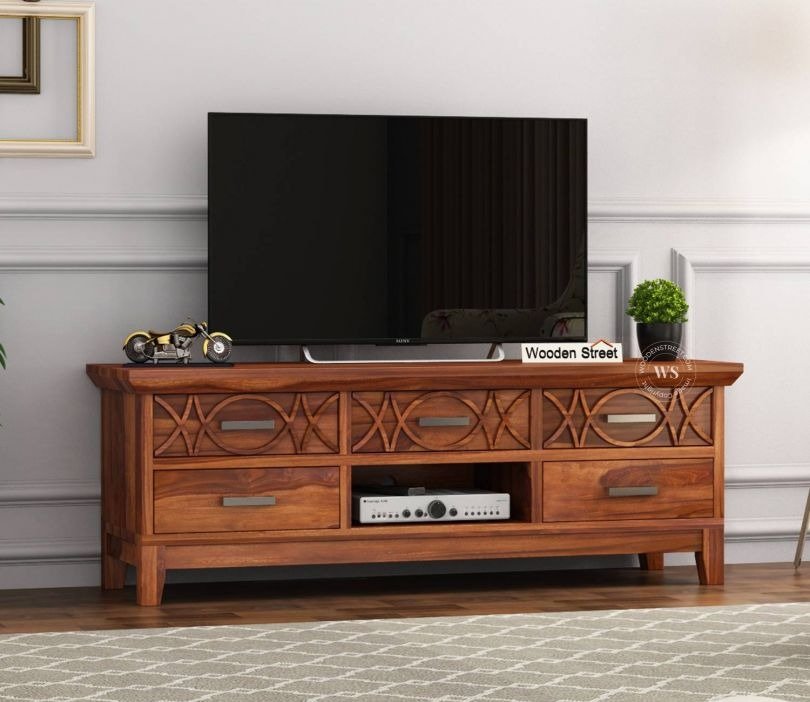Introduction
Choosing the right TV unit for your living room is more than just picking a spot for your television it’s about enhancing your space’s style, optimizing functionality, and meeting your daily needs. Whether you’re considering a sleek modern TV stand, a spacious TV cabinet, or a classic wooden TV unit, there are essential factors to weigh: your room’s size, your storage requirements, the unit’s material, cable management, and design coherence with your decor. This complete guide will walk you through every step, helping you make an informed decision that elevates both the look and usability of your living room.
1. Understanding the Different Types of TV Units
TV Stand
A TV stand is often a low-profile piece that elevates your television and may include open shelving or minimal storage. It’s ideal for modern or minimalist aesthetics and works well in smaller spaces. Opt for a stand if you want easy access for remotes, consoles, or decorative items.
TV Cabinet
A TV cabinet typically offers more enclosed storage think doors, drawers, or compartments that hide clutter and electronics. This makes it perfect for family rooms where you want neatness and functionality wrapped in a stylish piece of furniture.
TV Unit
“TV unit” is a broad term encompassing both stands and cabinets, varying widely in design and storage options. It can refer to wall-mounted units, floating shelves, or traditional long units—often modular in nature.
Wooden TV Unit
A wooden TV unit brings warmth, longevity, and eco-friendly appeal. From light oak to rich walnut, wood suits both rustic and modern decors, and its sturdy nature makes it a durable choice. If sustainability is a priority, look for responsibly sourced wood or recycled materials.
Tip: Choose the specific format depending on your storage needs, aesthetic preferences, and room size. Balance open vs. closed storage and match the piece’s height and width to both the TV size and the furniture around it.
2. Measure and Match to Your Space
- Width: To maintain visual balance, your TV cabinet or TV stand should be about equal to or slightly wider than your TV. A general rule: the unit’s width should be at least the size of the TV panel, allowing space for decor or devices on either side.
- Height: Ideally, the center of the TV screen should align with your eye level when seated—usually about 42–48 inches from the floor. This helps reduce neck strain and enhances viewing comfort.
- Depth & Clearance: Make sure there’s enough depth to accommodate your hardware—say, game consoles or soundbars without blocking ventilation. Leave a few inches of clearance behind for cables and airflow.
- Room Fit: Consider the overall layout. If your living room has a low seating arrangement or if the TV wall is shared with windows or shelves, harmonize the TV unit dimensions accordingly.
Use measuring tape or a digital app to layout both your TV unit and surrounding furniture virtually before buying.
3. Storage & Functionality Needs
Device Storage
Think about whether you need open compartments for quick access or closed drawers and doors for a tidy appearance. If you have multiple devices (streaming boxes, gaming systems, routers), prioritize:
- Adjustable shelves for accommodating various device sizes
- Ventilation holes or mesh panels for heat dissipation
- Removable back panels or cable-routing features for cleaner wiring
Media & Cable Management
Look for integrated cable channels, hidden wire holes, or built-in baskets to corral cords discreetly. For high-end TV cabinets, some designs come with pull-out trays for peripherals or built-in shelving for media storage.
Additional Features
- Mounting Options: Some TV units allow for mounting the screen directly to the back panel, eliminating the need for a separate bracket.
- Swivel Mechanism: Useful for corner setups lets you tilt or pivot the TV toward different seating areas.
- Adjustable Shelves: Flexibility to reconfigure spacing for speakers, decor, or books.
4. Style, Material & Finish
Material Choices
- Solid Wood: Classic, durable, and repairable. Highlights natural grain patterns.
- Engineered Wood (MDF, Particleboard): Cost-effective and available in a variety of finishes. Less resilient to moisture and heat than solid wood.
- Metal & Glass Accents: Add an industrial or modern touch ideal for minimalist decors.
- Mixes (Wood + Metal): Combine warmth with visual contrast trendy and versatile.
Finish and Color
- Natural wood tones: Bring warmth and cozy vibes; styles like rustic, farmhouse, or mid-century modern benefit.
- Painted or Lacquered Finishes: Offer color pops or sleek, uniform surfaces best for contemporary and modern interiors.
- Matte vs. Gloss: Matte hides dust better; gloss gives a luxe, shiny look but may show fingerprints.
Design Coherence
Your TV unit should complement existing furniture and décor. For example:
- Match wood tone with coffee/table surfaces
- Coordinate cabinet handles or hardware with your room’s metallic accents
- Reflect overall room style (e.g., clean lines for minimalism, rounded corners for a Scandinavian look)
5. Maintenance & Longevity
- Cleaning: Solid wood benefits from gentle cleaning and occasional conditioning; engineered materials may only require a damp cloth. Avoid harsh chemicals.
- Wear & Tear: Corners should be rounded if you have kids or pets. Drawers and doors should be sturdy and easy to open.
- Upgrade Flexibility: Modular units or those with adjustable shelves adapt better to future media changes (e.g., upsizing to a larger TV or adding components).
6. Budget Planning

- Entry-Level (Under $300): Basic stock TV stands or laminated TV units functional, affordable, but may offer limited customization.
- Mid-Range ($300–$800): Better materials, smart storage features, more refined finishes and design.
- Premium ($800+): Solid wood construction, bespoke designs, hidden cable systems, or integrated mounts. Great for long-term investment.
Pro Tip: Don’t just look at sticker price evaluate what the unit offers in terms of features like ventilation, cable management, build quality, finish, and adaptability.
7. Making the Final Decision
Here’s a quick checklist to guide your final pick:
- Placement: Does it fit the room layout and visual balance?
- Material: Solid wood for longevity, or engineered options for budget-conscious flexibility?
- Storage: Enough compartments for current and future needs, with adequate ventilation?
- Cable Management: Hidden or accessible wiring to keep clutter at bay?
- Style: Does it harmonize with your decor and furniture?
- Ergonomics: TV eye-level seating, comfortable viewing angles, adjustable features?
- Value: Does the price align with quality and expected lifecycle?
Try marking potential TV units with painter’s tape on floor/wall to visualize scale, or mock up shelf placements to test device fit.
Conclusion
A well-chosen TV unit transforms your living room into a more inviting, organized, and enjoyable space. Whether you lean toward a sleek TV stand, a concealed TV cabinet, or a warm wooden TV unit, focusing on fit, storage, style, and ergonomics will ensure your choice uplifts both form and function. Keep measuring accurately, prioritize what storage and cable management you need, and align the design with your decor. With this complete guide, you can confidently select a TV unit that complements your lifestyle, supports long-term enjoyment, and stands strong against changing technology and trends.
Related Reads
- Custom Fitness App Development: Build the Fitness App Your Users Actually Want
- Destination Wedding Planners in India – Create Your Dream Wedding with Doli Saja Ke Rakhna
- How Programmatic Buying is Transforming iGaming Ads
- Visionaries Who Reshaped Global Business: Best CEOs in the World
- The Importance of Agriculture in Uttar Pradesh
- Best General Physician Hospital in Hyderabad | Revive Hospitals Attapur



